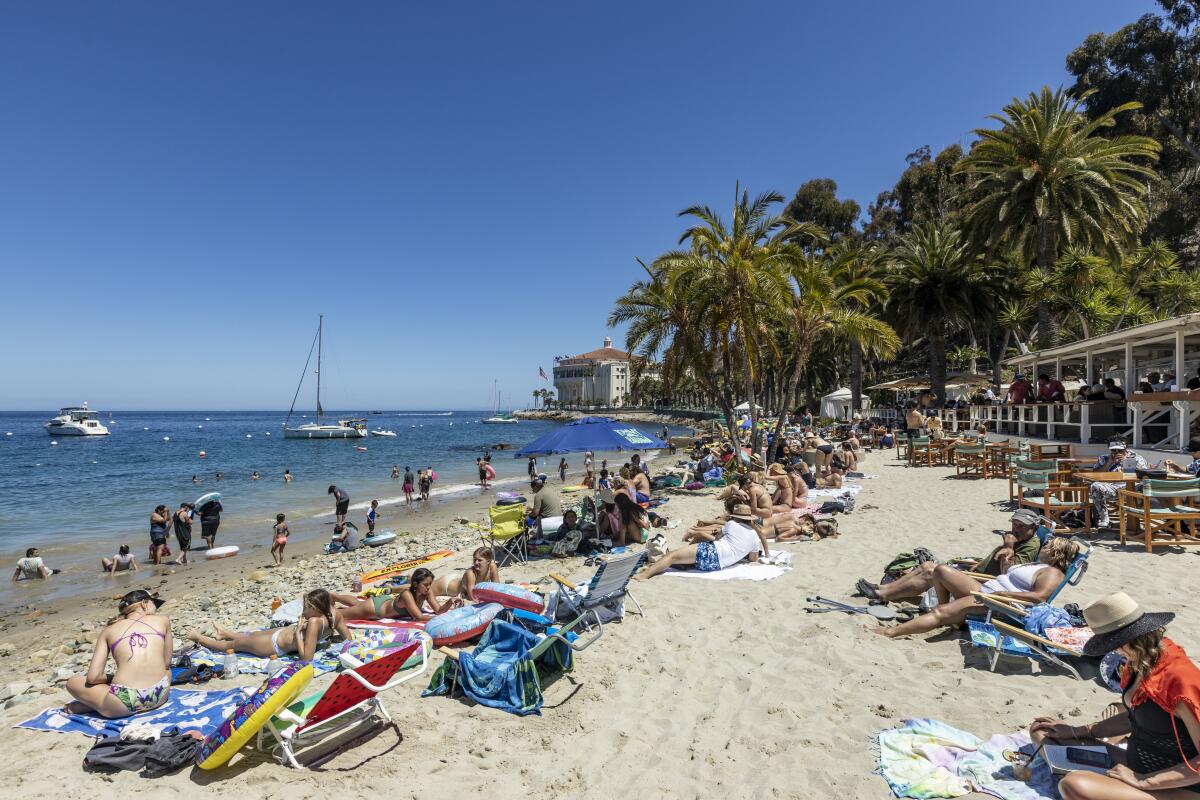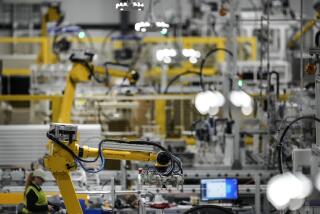U.S. GDP roars past pre-pandemic levels. Where does the economy go from here?

- Share via
WASHINGTON — Even with production glitches, transportation bottlenecks and labor shortages, the U.S. economy grew in the second quarter at one of the fastest rates in decades, lifting the nation’s total output above where it was before COVID-19 hit, according to government data released Thursday.
“That we were able to recover so quickly is astounding,” said Beth Ann Bovino, U.S. chief economist at S&P Global Ratings.
The question now is whether the extraordinary growth surge reflects the basic strength of the economy or stems from other factors that could fade away.
The extra federal aid for the unemployed in many states does not expire until Sept. 6. Previous government relief efforts approved during the height of the early pandemic shutdown are still helping the economy. And even if Congress whittles down President Biden’s massive infrastructure plan, many analysts expect a significant new burst of federal spending to be approved.
Bovino credited what she calls “revenge spending” for the rapid growth.
“Everybody was locked up for so many months. They’re going to go out, they’re going to party — and I can’t blame them,” she said. “Right now, it’s V-day for the United States.”
The Commerce Department said that the nation’s gross domestic product, the broadest measure of economic output, expanded at an annual rate of 6.5% in the last quarter. Analysts were expecting a pace of about 8%, but a sharp drop in housing investment and higher inflation curtailed real growth.
Still, apart from the initial snapback after the pandemic-induced plunge last year, the latest rise in GDP was an increase from the first quarter’s 6.3% annual rate and marked the strongest growth of any quarter since 2003.
Rising prices and especially the Delta variant of the coronavirus present threats to the recovery. But so far there’s been little effect on consumer spending, which accounts for about two-thirds of U.S. economic activity.
Traffic at restaurants, airports and entertainment venues has held up well. And hotel occupancy is now above pre-pandemic levels as people make up for lost time visiting families and others move to new locales.
In the second quarter, spending on services jumped 12% from the preceding three months, slightly more than for goods purchases. Many consumers still have a reservoir of pandemic-inspired savings to satisfy their pent-up demand, and businesses, states and local governments got large infusions of federal assistance in the spring.
“The scale of the government stimulus, both federal and state, is so huge that money can’t be spent fast enough representing substantial future spending,” said Sung Won Sohn, professor of finance at Loyola Marymount University in Los Angeles.
The new GDP report shows business spending also made solid gains in the last quarter. And strong corporate profits have buoyed stock markets, even as they have been more wobbly in recent days.
Despite the caveats and uncertainties, most economists expect the economy to keep expanding at a rapid pace in the near term, with many forecasting GDP growth for all of 2021 at 6% to 7%, which would be the strongest since 1984.
At the same time, analysts and policymakers are paying especially careful attention to the Delta variant because it may be uniquely capable of drastically altering their projections.
States with low vaccination rates that have seen a surge of infections and hospitalizations lately, such as Missouri and Louisiana, make up a relatively small part of the U.S. economy and hence are not likely to be a big drag on national output.
Florida, though, is an exception. Not only large, it has been one of the hardest hit by the variant and is showing some signs of weakening economic activity, according to various indicators compiled by Moody’s Analytics.
Additionally, one of the ways that the variant could crimp the broader economy is by exacerbating production problems and the availability of goods for purchase-hungry consumers.
Increased infection rates and more hospitalizations could intensify labor shortages. A worsening pandemic could also cause more people to stay at home and more schools to remain online.
Already, shortages of workers and supplies of crucial products such as semiconductors have slowed economic activity, particularly in the car industry.
In May, economists at the Federal Reserve Bank of Atlanta projected annualized GDP growth of almost 14% for the quarter. But over successive weeks they cut that in half as manufacturers and car dealers struggled to meet booming demand, and deliveries of many goods were delayed by bottlenecks at ports and a lack of truck drivers and other workers. Soaring prices for homes and commodities such as lumber also hurt home building as well as sales for many small businesses.
Tom Straus, owner of Straus Carpets in Oakland, said sales last month were the biggest in his 46 years of business. But they could have been even better had he been able to get supplies.
Whether it’s wool carpets, vinyl tiles, plywood, glue or rubber paddings, deliveries have been running weeks or months behind normal times, he said.
And finding workers hasn’t been any easier. About a month ago Straus bumped up the pay for installers by 15% to keep his employees happy in the face of rising prices for gas and food. “We placed an ad on Craigslist for installers as the business has gone crazy,” he said.
As quickly as the nation has come out of the pandemic-induced downturn — which at two months was the shortest recession on record — the rebound has been highly uneven and could leave a permanent mark on the nation’s labor market.
The economy has recovered about two-thirds of the 22.3 million payroll jobs lost when the coronavirus first struck early last year. Workers have been slow to return. Many older people have retired early, and some in the prime of their working lives may stay on the margins of the workforce.
“It’s great that we brought back GDP to where it was in dollar terms to where we were in 2019, but that doesn’t mean that we’re back on the path where we were before,” S&P’s Bovino said. “We’re not. We’ve lost the workers.”
Economists expect millions of jobs will be added in coming months but don’t think all the jobs will be regained until the end of next year. And it’ll be even later before the unemployment rate — most recently at 5.9% — returns to the pre-pandemic level of 3.5%.
The shrunken workforce coupled with a growing economy means that it’ll be a favorable climate for certain workers, particularly in transportation, manufacturing and service occupations. There are record openings, and many people have quit jobs as they rethink work amid the pandemic.
“For the foreseeable future, this is really an employees’ market,” said Leo Feler, an economist at the UCLA Anderson School of Management. “Employees have greater ability to jump between jobs, to be able to get better wages and better benefits than they had in the past. There’s still a lot of unemployment, but what you also have is companies desperately trying to hire as they ramp up to meet client and consumer demand.”
Though the current quarter is looking as strong as the second, what happens in September may tell the tale of the near-term economy.
Expanded unemployment benefits and other aid to households expire that month. And if schools reopen and children return to in-person classrooms as many expect, that could free up more parents who have been at home caring for their children to return to the job market, helping ease the labor crunch and supply bottlenecks.
More to Read
Get the L.A. Times Politics newsletter
Deeply reported insights into legislation, politics and policy from Sacramento, Washington and beyond. In your inbox three times per week.
You may occasionally receive promotional content from the Los Angeles Times.











